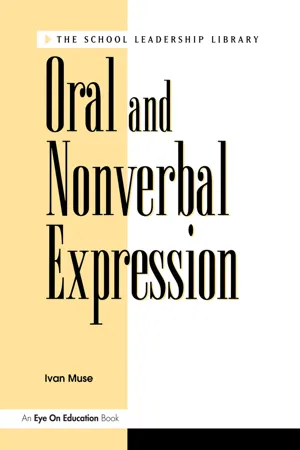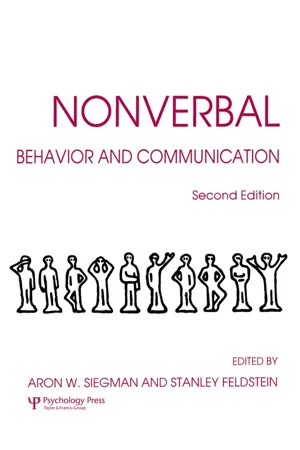Languages & Linguistics
Paralanguage
Paralanguage refers to the non-verbal elements of speech, such as tone, pitch, volume, and speed. It includes vocal qualities that convey meaning, emotion, and attitude, and can greatly influence the interpretation of spoken language. Paralanguage plays a crucial role in communication, as it helps to convey nuances and subtleties that may not be expressed through words alone.
Written by Perlego with AI-assistance
Related key terms
Related key terms
1 of 4
Related key terms
1 of 3
11 Key excerpts on "Paralanguage"
- eBook - ePub
Social Skills
Developing Effective Interpersonal Communication
- Alex Kelly(Author)
- 2018(Publication Date)
- Routledge(Publisher)
So what skills are involved in conversations? There are eight verbal behaviours that are important within a conversation: listening, opening a conversation, maintaining the conversation through taking turns, asking questions, answering questions, being relevant, repairing, and ending a conversation. But before we focus on listening, we will consider the nonverbal elements of the words: paralinguistic skills, because the two areas are interlinked. As a listener, we must focus on listening to the person in the truest sense. This means we should not just listen to the words being spoken, but to the true meaning and the feelings behind them, and we do this by listening to the Paralanguage.Paralinguistic skills or prosody
Paralinguistic literally means ‘beyond words’ (from the Greek word ‘para’ which means beside or beyond) but they are also known as ‘vocal cues’ or ‘prosody’ or ‘the way we talk’. It is commonly referred to as ‘that which is left after subtracting the verbal content from speech’ (Hargie et al., 1994). Paralinguistic skills are therefore nonverbal behaviours as they are not to do with the verbal content of the message but the feeling behind it, therefore they are best described here in this chapter as they affect the conversation very directly.In a conversation, the listener hears far more than the speaker’s words. They listen to the pitch, the rate of speech, the volume, clarity and fluency. Prosody will help us to know which words are the important ones to listen to and ‘are there to direct us to the words that matter most’ (Boyce, 2012). These cues give words their meaning and they will tune us into the message behind them, making up 38% of our communication according to Mehrabian’s research (1971) which we discussed in Chapter 2 .That is why when we meet someone for the first time, we often don’t remember their name or the details of what they said, because we are concentrating on ‘listening’ to the essential aspects of their nonverbal communication: their body language and the way they talk. It is this that tells us: this person is trustworthy or funny, arrogant or stressed. The psychotherapist Rollo May (1969) said ‘I love to feel where words come from’ and also that when someone enters his consulting room he asks himself, ‘what does the voice say when I stop listening to the words and listen only to the tone?’There are three levels to prosodic function according to Attwood (2016): grammatical, pragmatic and affective. The grammatical function is to communicate aspects such as a question (with a rising pitch), or a statement (with a falling pitch), or whether a word was intended as a noun or a verb. The pragmatic function is to provide social information to the listener such as our opinion, our thoughts or to emphasise what we want to draw the listener’s attention to. The third function is the affective function which communicates feelings and attitudes. This tells the listener how we are feeling – are we happy and interested or anxious and needing reassurance – when we call out and say ‘come here’. - Jane Jackson(Author)
- 2019(Publication Date)
- Routledge(Publisher)
et al. 2004: 258). It is important to pay attention to these nonlinguistic features of communication as they are ‘often what give verbal messages their full meaning’ (ibid: 258). It is through enculturation that we learn to recognize and interpret Paralanguage in our home environment (e.g., develop an understanding of what vocal cues and behaviors are appropriate in particular situations). Therefore, when we engage in intercultural communication we are apt to encounter unfamiliar paralinguistic cues, or perhaps not notice them.Nonverbal communication specialists have identified multiple characteristics of sound that contribute to the vocalic meaning associated with speech, including loudness (the volume and degree of intensity of the voice), pitch, duration (how long a particular sound is made), quality, regularity, articulation, pronunciation, and silence (e.g., Eaves & Leathers 2018; Moore et al. 2014). Belching, crying, gasping, grunting, laughing, sighing, whining, and yawning are also of interest as long as these sounds transmit messages.The use and interpretation of paralinguistic cues can vary depending on the cultural context, which can complicate intercultural communication. For example, vocal qualifiers such as volume, pitch, rhythm, and tempo may differ among people who have been socialized in diverse regions. In some contexts, speaking loudly indicates sincerity, whereas in others it is interpreted as aggressive. Vocal segregates (utterances such as mmmm, uh-huh, oooo), vocal rate (the speed at which people talk), and vocal characterizers (e.g., laughter, belching, grunting) may also differ in diverse cultural contexts and be interpreted differently. For example, belching during or after a good meal is a common and accepted practice in some parts of the world and yet considered vulgar and inappropriate in other contexts.- eBook - ePub
- Gillian Brown(Author)
- 2017(Publication Date)
- Routledge(Publisher)
6 Paralinguistic featuresParalinguistic features of speech are those which contribute to the expression of attitude by a speaker. They are phonetic features of speech which do not form an intrinsic part of the phonological contrasts which make up the verbal message: they can be discussed independently of the sequences of vowels and consonants, of the stress patterns of words, of the stressing of lexical rather than grammatical words, and of intonation structure which determines where the tonic syllable falls. Hitherto the features of speech which we have discussed have been features which contribute directly to the interpretation of the verbal content of the message and its organization by the speaker in terms of information structure. Now we turn to consider those aspects of speech which contribute to a meaning over and above what the verbal element of the message means. Following a well-established distinction, we shall call the meaning contributed by the verbal content the 'conceptual' meaning of the utterance, and the meaning contributed by the paralinguistic features the 'affective' meaning of the utterance, where the feelings and attitudes of the speaker are to some extent revealed to the listener. (For a fuller discussion of this distinction, see Leech, 1974.)The paralinguistic features of speech are not, of course, isolated from other modes which are available to the speaker by which a particular attitude can be indicated towards the person being addressed or towards what is being spoken of. They relate closely to the phenomenon often referred to as 'body talk' or 'body language'—which refers to gesture, posture, facial expression and so on, all of which may have an effect on the way the listener interprets what the speaker says. If the speaker says 'That's very interesting' leaning forward with a bright alert look, the listener is likely to think that this is really what the speaker means, whereas if the speaker utters the same words but twisting to look out of the window and stifling a yawn, the listener might reasonably conclude that the speaker is not actually very interested. The body language of the speaker forms part of the wider context of utterance in which what is said is interpreted. I shall concentrate on the paralinguistic features of speech, rather than include a general discussion of these features within the wider setting of body language in general, because these are features which we listen to, and which we can hear over the radio, telephone or tape recorder—they fall squarely within the province of a discussion of 'listening' to spoken English. In our everyday experience of language it is usually the case that the paralinguistic vocal features will reinforce the content of what the speaker says. Thus our unmarked, neutral expectation will be that someone who says 'What a lovely day' will say it enthusiastically, that someone who says 'I am sorry' will say it sincerely, and that someone who says 'And now get out of here' will say it angrily. It is relatively rare, but by no means uncommon, to encounter a mismatch between the verbal content of the utterance and the way it is said—it is on such occasions that expressions like 'It's not so much what he said as the way he said it that upset/struck/ infuriated me' are appropriately used. Where such a mismatch occurs, listeners tend to pay more attention to the way something is said than to the verbal content. Lyons (1972) writes of this phenomenon in the following terms: - eBook - ePub
Ideology and Conference Interpreting
A Case Study of the Summer Davos Forum in China
- Fei Gao(Author)
- 2023(Publication Date)
- Routledge(Publisher)
Gussenhoven, 2004 ). For example, when speakers are enthusiastic about certain messages and want to emphasise them, listeners are likely to hear both notably high and low pitches within a span of a word or a few words.Such pitch variations are implemented by Paralanguage which is more or less universally shared across many world languages (Gussenhoven, 2002 , 2004). Paralanguage universal is the theoretical base for the model of Effort Code (Gussenhoven, 2004 ). Paralanguage refers to a non-grammaticalised phonetic phenomenon; it modifies meaning, generates nuanced meaning, or conveys emotion, through using techniques such as prosody and non-codified intonation (Gussenhoven, 2004 ; Ladd, 2008 ). Languages are different, but Paralanguage is similar because it is “rooted in anatomical and physiological factors” (Gussenhoven, 2016 , p. 245) that are shared by humans. Therefore, paralinguistic communication gives rise to meaning universals that stem from the biologically coded speech production mechanism (Gussenhoven, 2004 , 2016). Halliday and Greaves (2008 ) espouse this perspective: “[W]e share the same brain and bodily structure, there is much in common both to the sounds we can produce and hear and to the meanings we can express and understand” (p. 42). The ‘bodily structure’, or the biological mechanism, affects the way the larynx and the pulmonic air stream produce vocal fold vibrations. The homogeneous structure of the human body is, therefore, the physiological base that allows humans to produce and perceive paralinguistic intonation similarly.The intentional use of extra articulatory effort in realising the emphatic meaning is not specific to a language, but universal to the phonetic implementation of the Paralanguage. The purposeful variation in the phonetic implementation is understood as the universal paralinguistic intonation, which differs from the structural intonation that is “morphologically and phonologically” (Halliday & Greaves, 2008, pp. 57−58) encoded as part of the grammar of certain languages. In other words, the biological mechanism of human speech production provides the possibility of communicating through paralinguistic universals; the uses of paralinguistic intonation are “remarkably similar across languages” (Chen, Gussenhoven & Rietveld, 2004 - eBook - ePub
- Ivan Muse(Author)
- 2013(Publication Date)
- Routledge(Publisher)
The way that an individual uses language can say as much about the person as the words and sentences uttered. Paralanguage consists of nonverbal voice cues that accompany speech. The speaker’s loudness, speed of speech, pitch of voice, tone or emphasis on words, and inflection give added meaning to the spoken words. Even stuttering, whimpering, yawning and giggling give the observer impressions of the speaker and the intent of the message. A few people stutter when they become nervous or feel strongly about some issue being discussed. Giggling can also occur as a result of being nervous or in attempting to suppress a full laugh about something considered funny or entertaining. A “slip of the tongue” comment can create a laughing situation that shouldn’t be considered as negative unless the laughter is at someone’s expense and they are made to feel foolish.Paralanguage is often overemphasized in telephone conversations because the speaker is not able to use body movements to emphasize meaning. As a person speaks, the listener attempts to determine the feelings and emotional levels being expressed. In the following examples, consider the expressions from listeners as they attempt to respond to Paralanguage cues:♦ “I don’t like the tone of your voice.” ♦ “I know it’s important, you don’t have to shout.” ♦ “Are you serious or just kidding?” ♦ “You sure are in a bad mood today.” ♦ “Are you asking or telling me to do that?” When a speaker uses loudness, the intent may be to emphasize a point, gain attention, stress some action or indicate a desire to be included in a discussion. Pitch is useful in determining if a sentence is a statement, question or a sarcastic barb. For instance, the phrase, “Are you ready to go?” can be merely a statement of readiness, a question of preparedness, or a teasing statement sarcastically indicating that it is a known fact for the individual to usually be late and seldom ready on time.Speed in speech is used when a speaker wishes to be more persuasive or to emphasize a thought. It has been found that speakers who increase volume and the rate of talking are able to gain more attention and interest of others. This knowledge is used by those who produce television commercials. The producers realize that they only have a few brief seconds to display the ads and that they must capture audience attention before they change stations or leave the TV for a break. By increasing the volume and the rate of speech, producers can persuade many viewers to remain and watch the commercial. - No longer available |Learn more
- John D. DeLamater, Jessica L. Collett(Authors)
- 2018(Publication Date)
- Routledge(Publisher)
Table 9.2 ) are described next.Paralanguage. Speaking involves a great deal more than the production of words. Vocal behavior includes loudness, pitch, speed, emphasis, inflection, breathiness, stretching or clipping of words, pauses, and so on. All the vocal aspects of speech other than words are called Paralanguage . This includes such highly communicative vocalizations as moaning, sighing, laughing, and even crying. Shrillness of voice and rapid delivery communicate tension and excitement in most situations (Scherer, 1979). Various uses and interpretations of paralinguistic and other nonverbal cues will be examined later in this chapter. For now, see how many distinct meanings you can give to the sentence “Asad is on the phone again” by varying the paralinguistic cues you use.Table 9.2 Types of Nonverbal CommunicationTYPE OF CUE DEFINITION EXAMPLES CHANNEL Paralanguage Vocal but nonverbal behavior involved in speaking Loudness, speed, pauses in speech Auditory Body language (kinesics) Silent motions of the body Gestures, facial expressions, eye gaze Visual Interpersonal spacing (proxemics) Positioning of body at varying distances and angles from others Intimate closeness, facing head-on, looking away, turning one’s back Primarily visual; also touch, smell, and auditory Choice of personal effects Selecting and displaying objects that others will associate with you Clothing, makeup, room decorations Primarily visual; also auditory and smell Body Language. The silent movement of body parts—scowls, smiles, nods, gazing, gestures, leg movements, postural shifts, and so on—all constitute body language . Because body language entails movement, it is known as kinesics (from the Greek kinein - eBook - ePub
Phone Therapy
A Guide for Practitioners Working with Voice Alone
- Sarah Hart(Author)
- 2022(Publication Date)
- Routledge(Publisher)
Some Paralanguage researchers include body language cues too and as Peter Matthews (2014) says, ‘The boundaries of Paralanguage are (unavoidably) imprecise’. As phone therapy is concerned with voice and hearing without sight, our focus will be on what our clients say, how they say it, as well as the communication that occurs far beyond the words they speak. Our client’s choice of words, along with their gasps, sighs, throat clearing, whispers, shouts, laughter, crying, speeding up, slowing down and being completely silent – gives us a wealth of information about who they are, their experiences and emotional state. Vocal characteristics — pitch, tone and intonation The sound of someone’s voice is as unique to them as how they look but even so, vocal characteristics fall into the following categories. Pitch is the highness or lowness of a person’s vocal tone. As outlined in Chapter 1, frequency measures the cycle rate of a sound wave and pitch is how high or low it sounds when you hear it. The smaller the larynx the higher the pitch which is why women tend to have higher voices than men. We might notice when a man has a higher pitch. Political scientist Casey Klofstad (2016) examined how vocal perceptions influence decision-making and found that in Western cultures, lower pitches are viewed favourably for both men and women in terms of strength, dominance and electability. A case in point is British Prime Minister Margaret Thatcher, who had voice coaching to make her voice sound lower and more commanding. Klofstad found that low is generally preferred in a leader, but the question up for debate is whether they actually are a better leader. Interestingly, higher pitches were preferred in East Asian countries, which illustrates the importance of context and interpretation when we work with clients - Meifang Zhang, Dezheng (William) Feng, Meifang Zhang, Dezheng (William) Feng(Authors)
- 2020(Publication Date)
- Routledge(Publisher)
On a micro level, SFL has also been developed to the study of Paralanguage such as gestures and phonology (Zappavigna, Cléirigh, Dwyer, and Martin 2010), which suggests ready applicability to interpreting research. A particular source of inspiration for the present research has been Martin and Zappavigna’s (2019) social semiotic framework for analyzing Paralanguage. Similar to the textual analysis in SFL, this framework deals with Paralanguage also from the three metafunctions of ideational, interpersonal, and textual meaning. In analyzing the manifold intermodal relations among language, Paralanguage, and other modalities, this framework draws a clear distinction between non-semiotic behaviour (somasis) and meaning (semiosis). Semiosis is then divided into language and Paralanguage. In this framework, the term Paralanguage refers to semiosis dependent on language and realized through both sound quality and body language, the latter includes facial expression, gesture, posture, and movement (ibid., 3). Within Paralanguage, sonovergent and semovergent resources are identified. The former represents Paralanguage that is “in sync with or in tune with the prosodic phonology of spoken language” (ibid., 1), while the latter represents Paralanguage that is convergent with the lexico-grammar and discourse semantics of the spoken language, or resources that “support the ideational, interpersonal and textual meaning resources of spoken language’s content plane” (ibid., 1). More specifically, ideational Paralanguage is “mimetic,” concurring with ideation and connection systems; interpersonal Paralanguage is “expressive,” resonating with negotiation and appraisal systems; and textual body language is “deictic,” syncing with identification and periodicity systems (ibid., 11).2.3 Interpersonal meaning
We reviewed at the beginning of this section that SFL perceives three strands of meaning. Regarding the exploratory nature of this research and restricting it to a manageable scope, we focus on interpersonal meaning in the analysis. This strand of meaning is named interpersonal, as it reflects how the “interaction” and “transaction” between speakers and listeners are going on (Halliday 1994, 34). Realizations of interpersonal meaning in the verbal language include lexico-grammatical resources of mood and modality and semantic resources of appraisal. Mood is the “subject” and “finite” combination in a clause. Subject is interpersonal as it is “something by reference to which the proposition can be affirmed or denied.” Finite is interpersonal in two ways: first, finite modal operator (may, can, would, etc.) relates to “the speaker’s judgment of the probabilities, or the obligations, involved in what he is saying”; second, polarity, the “choice between positive and negative,” makes a clause arguable between the speaker and the listener (ibid., 75–76). Modality, on the other hand, shows the attitude of the speaker and is carried by modal adjuncts (certainly, probably, usually, etc). Speaker’s attitude is also reflected by the semantic system of appraisal, which is an extension and development of SFL by James Martin and Peter White (Martin 1992; Martin and White 2005). There are three semantic categories of appraisal: ATTITUDE, GRADUATION, and ENGAGEMENT. ATTITUDE relates to ways of feeling in three dimensions: affect, appreciation, and judgment. Affect relates to emotions like happiness, sadness, and pain; appreciation relates to the aesthetic quality of entities; judgment relates to the moral evaluation of good and bad. GRADUATION concerns with the gradable interpersonal force of discourse. ENGAGEMENT is the degree of the arguability of what the speaker is saying (Martin and White 2005).- eBook - ePub
- Aaron W. Siegman, Stanley Feldstein, Aaron W. Siegman, Stanley Feldstein(Authors)
- 2014(Publication Date)
- Psychology Press(Publisher)
Chomsky (1965) in support of the proposition that sentences with an apparently simple “surface” structure frequently conceal several underlying “deep” structures. It can be argued, however, that such ambiguities are a characteristic of the written code, but not of spoken language. The sentence, “I like Chomsky roasting” when read with equal stress on all the words, could mean: I like the fact that Chomsky is doing the roasting, or it could mean: I like the fact that Chomsky is being roasted. Vocal stress on either the word Chomsky or on the word roasting resolves this ambiguity. Similarly, intonations and stresses, pauses, and hesitations provide structure and tell us whether a statement is intended as a positive assertion or a question, or perhaps as sarcasm. It would seem fairly obvious that these nonverbal features of speech are not peripheral to but very much an integral part of spoken messages, of their meaning and structure. They certainly are nonlexical, but they are not extralinguistic. Yet traditionally the science of linguistics and the various theories and models of language have typically been based on written language and thus have failed to consider the nonverbal domain although, develop-mentally and historically, spoken language precedes written language; individuals and cultures speak before they write.Not all nonverbal vocal cues are an integral part of the meaning of a message. Some may reflect the speaker's background, changes in his mood, his attitudes and feelings toward the person whom he is addressing, or even cognitive decision making. It is this category of nonverbal vocal cues, perhaps best designated as extralinguistic (or paralinguistic), that is the primary focus of interest in this chapter.Because there does not yet exist a generally accepted system for categorizing the various vocal features that make up the extralinguistic domain, we simply list some of the more prominent variables in the extralinguistic research literature. Some are acoustic in nature, such as pitch level and pitch range, loudness and loudness range. These can be measured in terms of their physical properties or in terms of listeners' judgments. Others involve voice qualities, such as a nasal voice or a raspy voice; still others are related to the linguistic encoding process, such as speech tempo, pausing patterns, and speech disruptions. Some of these variables are discussed in greater detail in the context of specific studies. - eBook - ePub
Modelling Paralanguage Using Systemic Functional Semiotics
Theory and Application
- Thu Ngo, Susan Hood, J. R. Martin, Clare Painter, Bradley A. Smith, Michele Zappavigna(Authors)
- 2021(Publication Date)
- Bloomsbury Academic(Publisher)
5 Interpersonal Paralanguage: Approaching Paralanguage from the perspective of social relations5.1 IntroductionThis chapter focuses on interpersonal meaning in Paralanguage – on the ways in which the Paralanguage of facial expression, voice quality, body gestures and positioning express feelings and enact social relations in cooperation with spoken language. The data are drawn from an award-winning stop-motion puppet animation film Coraline , directed by Henry Selick (2009) and based on a novella of the same name written by Neil Gaiman (2002) .Analyses explore the paralinguistic systems of interpersonal sonovergence in which movements of parts of the body or face rise and fall in tune with the intonation contours of the prosodic phonology (see Section 5.2) and interpersonal semovergence in which paralinguistic expressions converge with interpersonal meanings in spoken discourse (see Section 5.3). In the latter the relevant interpersonal discourse semantic system is appraisal with its three subsystems of attitude (as affect only in this case), engagement and graduation (Martin and White, 2005 ; Martin and Rose, [2003] 2007 ; Martin, 2017a ). Reviews of these discourse semantic systems precede introductions to related paralinguistic systems – paralinguistic affect , paralinguistic engagement and paralinguistic graduation . Systems of body orientation , proximity and power are also briefly discussed. System choices are illustrated in instances from Coraline and discussion focuses on intermodal convergences in expressions of emotion and the enactment of inter-character relations.The story depicts the return adventure of the central character, Coraline, a pre-teenage girl who moves from the real world into a mirror (other) world through a tiny passageway behind a locked door in an empty room in the house her family has just moved into. Having been ignored by her busy parents and bored in the real world, Coraline finds herself the centre of attention from an ‘Other Mother’ and an ‘Other Father’ in the alternate world. However, she soon comes to realize that she has in fact been trapped by a sinister villain, Beldam, appearing in the disguise of Other Mother with the intention of capturing the souls of children. The clever and brave Coraline is eventually able to save herself as well as her real parents and the souls of three other trapped children. She returns to her real world with a greater appreciation of her real parents. - eBook - ePub
Language, Culture, and Society
An Introduction to Linguistic Anthropology
- James Stanlaw, Nobuko Adachi, Zdenek Salzmann(Authors)
- 2018(Publication Date)
- Routledge(Publisher)
Paralanguage. The most common paralinguistic features are usually assigned to three categories.Voice qualifiers have to do with the tone of voice and pacing of speech, and they include variations in volume or intensity (for example, overloud, oversoft), pitch (noticeably high, noticeably low), tempo (overly fast, overly slow), and articulation (for example, drawling, clipping, or rasping).Besides these and other voice qualifiers, there are various voice characterizers that accompany speech or, more precisely, through which one talks. These range from laughing and giggling to crying and sobbing to yelling, moaning, groaning, whimpering, and whining.And then there are the so-called vocal segregates, represented for the most part by such extralinguistic sounds (that is, sounds not part of the phonemic system) as the ones graphically represented in English texts as uh-huh to indicate agreement or gratification, uh-uh to indicate disagreement, tsk-tsk to express mild disapproval, and other graphic approximations of different kinds of snorts and sniffs.Here are some concrete examples of paralinguistic behavior: highly controlled articulation produces the crisp, precise pronunciation expected of formal pronouncements addressed to large audiences; by contrast, speech so relaxed as to become slurred is heard from those who are very tired, sleepy, or under the influence of alcohol or other drugs. Speakers of English and other languages tend to associate extreme pitch variation with happiness and surprise; high pitch level or fast tempo with fear, surprise, or anger; and low pitch level or slow tempo with boredom and sadness. The rounding of lips imparts to the voice the cooing quality that is frequently used by adults when talking to a baby.As an additional example, consider whispering. A person may whisper to avoid waking up others who are napping or sleeping (an example of thoughtful behavior); to avoid being overheard (consideration of privacy); to convey a secret or a conspiracy; or to spread rumors of an intimate nature about someone (hence the phrase “whispering campaign”).
Index pages curate the most relevant extracts from our library of academic textbooks. They’ve been created using an in-house natural language model (NLM), each adding context and meaning to key research topics.
Explore more topic indexes
Explore more topic indexes
1 of 6
Explore more topic indexes
1 of 4










